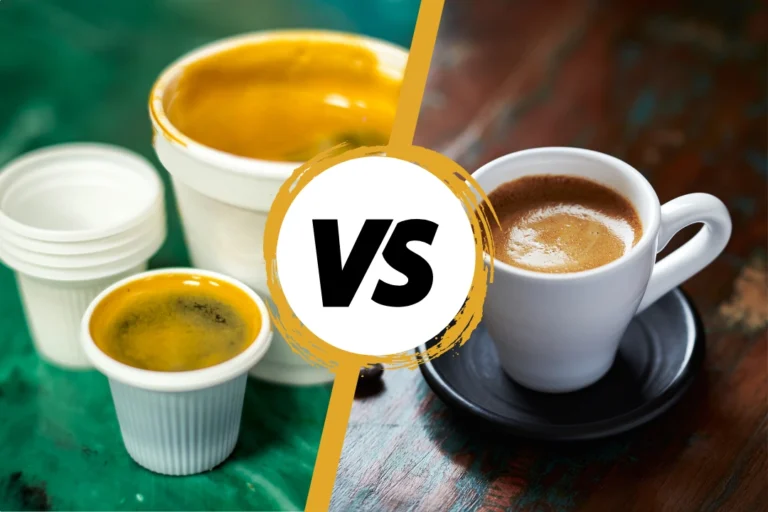When it comes to strong coffee, few drinks compare to the bold punch of Cuban coffee vs espresso. Both are rich, concentrated, and served in small cups, yet they deliver completely different experiences.
Espresso is all about precision and pure coffee flavor, while Cuban coffee adds sweetness and ritual. One focuses on technical extraction, the other on shared enjoyment.
In this guide, you’ll learn the real differences between Cuban coffee and espresso, how each is brewed, how they taste, how strong they are, and which one might suit your daily coffee routine best.
Espresso Overview
Espresso is a concentrated form of coffee made by forcing hot water through finely ground coffee under high pressure. It’s brewed using an espresso machine that produces about nine bars of pressure, resulting in a small shot of strong, full-bodied coffee.
A proper espresso has a thick layer of golden crema on top. This natural foam is created from coffee oils. It’s unsweetened and has a bold flavor that balances bitterness, acidity, and richness.
Espresso is also the foundation of many coffee drinks like cappuccinos, macchiatos, and lattes. On its own, it’s served in one- to two-ounce shots that deliver a quick burst of flavor and caffeine.
What Is Cuban Coffee?
Cuban coffee, or café Cubano, is an espresso-style coffee brewed using a moka pot on the stove. The difference lies in the preparation. Instead of serving it plain, Cuban coffee is sweetened during brewing by whipping sugar with the first drops of coffee to create a caramel-colored foam called espuma.
This foam is poured back into the coffee, giving it a rich sweetness and creamy texture. The result is a thick, syrupy espresso with a caramelized taste that’s smoother than traditional espresso.
Learn how to make authentic Cuban coffee at home in our guide.
Cuban Coffee vs Espresso – Brewing Method Comparison
| Aspect | Espresso | Cuban Coffee |
| Brewing Tool | Espresso machine | Moka pot (Cuban coffee maker) |
| Pressure Level | High (9 bars) | Low (steam-based) |
| Coffee Grind | Fine | Fine |
| Serving Size | 1-2 ounces | 1-2 ounces |
| Sweetened? | No | Yes, with sugar foam (espuma) |
| Crema Source | Natural coffee oils | Whipped sugar foam |
Flavor and Texture Comparison
Espresso has a bold, intense flavor with hints of chocolate, nut, or fruit depending on the roast. It’s sharp and concentrated, with a clean finish. The natural crema adds a silky texture, but the overall taste remains unsweetened and slightly bitter.
Cuban coffee tastes sweeter and thicker. The whipped sugar gives it a caramelized flavor and a velvety texture that feels almost syrupy. It’s less bitter than espresso and more approachable for those who like bold coffee without harshness.
Caffeine and Strength
A standard 1-ounce shot of espresso contains around 64 mg of caffeine, while a shot of Cuban coffee has about 40-45 mg, depending on how it’s brewed and the coffee-to-water ratio.
However, Cuban coffee feels stronger because of its sweetness and thick texture. The sugar amplifies the perception of intensity, even though the caffeine content is similar.
FAQ
Is Cuban coffee the same as espresso?
No. Cuban coffee is brewed similarly to espresso in a moka pot, but the key difference is the sugar. Cuban coffee is sweetened during brewing by whipping sugar with the first drops of coffee to create espuma, while espresso is served plain and unsweetened.
Can I make Cuban coffee in an espresso machine?
Yes, you can. Brew a shot of espresso and use the first few drops to whip sugar into foam. Then mix the rest of the espresso with that foam. The flavor will be close to traditional Cuban coffee, even if it’s made without a moka pot.
Why is Cuban coffee so sweet?
Cuban coffee gets its sweetness from espuma, a caramel-colored foam made by whisking sugar with hot coffee.
What type of coffee roast is best for each?
Both are best with dark roast coffee. Cuban coffee traditionally uses darker, oily beans for a smoky, caramelized flavor. Espresso can be made with medium to dark roasts, depending on how balanced or bold you want it to taste.
Key Takeaways on Cuban Coffee vs Espresso
Cuban coffee and espresso share the same bold spirit but express it in completely different ways.
- Espresso is brewed under high pressure in an espresso machine and served unsweetened. It focuses on pure coffee flavor, balance, and precision.
- Cuban coffee is brewed in a moka pot and sweetened with whipped sugar foam, giving it a caramelized, syrupy texture.
- Espresso delivers a crisp, clean finish, while Cuban coffee feels thicker, smoother, and naturally sweet.
- Both use finely ground dark roast coffee and are served in small shots for concentrated flavor.
- Cuban coffee feels stronger because of its sweetness and dense body, though the caffeine content is similar.

